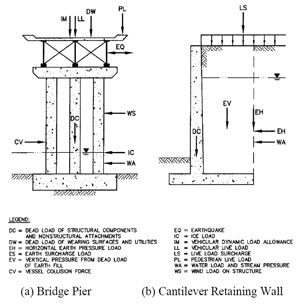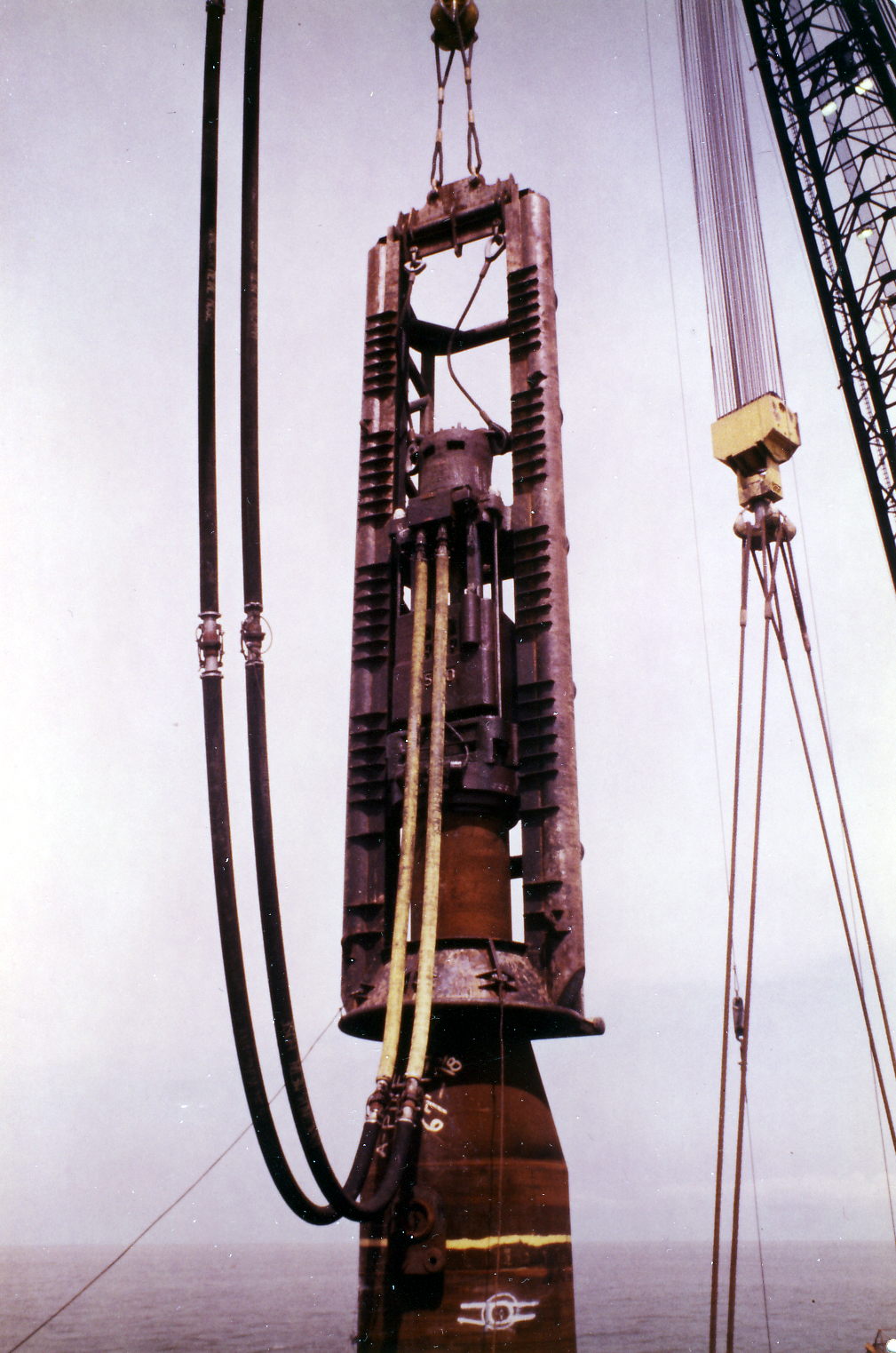
The ultimate objective of any driven pile is to carry some kind of load. These loads come from a variety of sources, as seen on the right.
Once the loads are established, the pile’s resistance to the loads must be established. The interaction of piles and the surrounding soils–axial and lateral–is complex. Computer software and spreadsheets can be very helpful, if certainly not a substitute for sound engineering judgement.
Below are some programs and one spreadsheet. We also offer the following:
- SPILE, FHWA’s DOS axial pile analysis program, bundled with the WEAP wave equation program
- TAMWAVE online wave equation and pile capacity routine, for academic and educational use
- BENT1 and PX4C3: two of the earliest programs, suitable primarily for academic use.
Click here for information on pile capacity and its determination.
CLM2 (Characteristic Load Method)
Spreadsheet for Microsoft Excel; documentation here.
The characteristic load method (CLM) of analysis of laterally loaded piles (Duncan et al., 1994) was developed by performing nonlinear p-y analyses for a wide range of free-head and fixed-head piles and drilled shafts in clay and sand. The results of the analyses were used to develop nonlinear relationships between dimensionless measures of load and deflection. These relationships were found to be capable of representing the nonlinear behaviour of single piles and drilled shafts quite accurately, producing essentially the same values of deflection and maximum moment as p-y analysis computer programs like COM624 and LpilePlus3. The principal limitation of the CLM method is that it is applicable only to uniform soil conditions. The Group Amplification Method was developed by Ooi and Duncan (1994), to extend use of the CLM method to groups of piles and drilled shafts. Values of group amplification factors for deflection and moment were computed using the method developed by Focht and Koch (1973).The original version of the CLM spreadsheet (Brettmann and Duncan, 1996) used the CLM method to calculate deflections and bending moments in single piles, and the Group Amplification Method to calculate deflections and moments for piles in pile groups. It was found that the original version of the spreadsheet resulted in accurate values of moment and deflection for single piles, but often over-estimated deflections and bending moments for the piles in pile groups, as judged by comparison with p-y analysis programs and the results of field load tests.
The revised spreadsheet uses p-y multipliers as the basis for improving the accuracy of pile group analyses. The p-y multiplier values used are those recommended by Mokwa and Duncan (2001) based on their field tests and review of recent literature.
COM624P
Note on the download file: it's a little different than some of the other DOS programs we offer in that you don't run the program directly from the file but unzip the contents and install the program onto the "hard drive" of your DOSBOX installation. After you unzip the contents, run the "INSTALL.BAT" program and follow the directions carefully.
Click here for program documentation (pdf format)
Note: a helper for this program is available here.
A program for the analysis of the deflection and capacity of piles under lateral loads. It was developed by Lymon C. Reese and his colleagues at the University of Texas at Austin, and is based on the p-y curve method. The program solves the equations giving pile deflection, rotation, bending moment, and shear by using an iterative process due to the non-linear response of the soil. COM624P is a DOS program which is installed as described above. Complete instructions and documentation is also available here as well.
Laterally Loaded Piles and Computer Program COM624G
(COM624G was a predecessor to COM624P. This report provides additional information on the program above.)
Lymon C. Reese; Larry A. Cooley and N. Radhakrishnan
U.S. Army Corps of Engineers Technical Report K-84-2
April 1984
When the soil immediately below the base of a structure will not provide adequate bearing capacity , piles can be used to transfer load from the structure to soil strata which can support the applied load . This report deals with analysis of the lateral interaction of pile shaft and soil. Examples of such problems encountered by the Corps of Engineers are single-pile dolphins and baffles for grade control structures.
A computer program called COM64, along with the documentation, was developed at the University of Texas (tu) at Austin, to analyse laterally loaded pile problems. Analysis performed by Program COM624 is dependent upon soil parameters input to the program. These soil parameters take the form of curves which simulate the nonlinear interaction of the pile and surrounding soil. The tu report also presented criteria for developing these soil response curves in various types of soils.
This report consolidates the information available on laterally loaded pile analysis and provides supplementary on Program COM624 (re-designated as COM624G). It describes modifications made in the input procedures and the addition of graphics options. Several examples of laterally loaded pile problems encountered in the Corps are added. Also included is a procedure for non-dimensional analysis of laterally loaded piles which can be used to perform companion hand calculations to verify the results of computer solutions.
DRIVEN
Click here for program documentation (pdf format)
DRIVEN is a Microsoft Windows 95/98/Me/2000/XP program, developed by the FHWA, to analyse the axial capacity of driven piles. Thurman (1964), Meyerhof (1976), Cheney and Chassie (1982), Tomlinson (1980, 1985), and Hannigan, et.al. (1997). The Nordlund and Tomlinson static analyses methods used by the program are semi-empirical methods and have limitations in terms of correlations with field measurements and pile variables which can be analysed. The user is encouraged to review further information on this subject in the “Design and Construction of Driven Pile Foundations” manual.DRIVEN is downloaded and installed as follows:
- Download the driven.zip file into a temporary directory.
- Open the file with an appropriate file and extract the installation file into a temporary directory.
- Run the installation file, following the instructions.
- If you need it, download the instruction manual by clicking its hyperlink below.
LLP99 (Laterally Loaded Pile)
This is a program for the analysis of a laterally loaded pile. It calculates the lateral displacements of the pile for a lateral load and a moment applied at the head of the pile. Input consists of the properties of the soil layers along the pile shaft, and the force and moment applied at the top of the pile, in a number of loading steps. Output is given on the screen, in the form of the response of the top of the pile. Input and output data can be printed, and are written to the data file of the problem when it is saved after the analysis. These data can be inspected using a text editor. Documentation is in the program help.The program must be extracted from a ZIP file before use. It is written for Microsoft Windows 95/98/Me/NT/2000/XP operating systems, and comes courtesy of Dr. Arnold Verruijt.



I think this is one of the so much significant information for me.
And i’m glad studying your article. But should commentary on some general issues, The website style is perfect, the articles is truly nice : D.
Good process, cheers
LikeLike